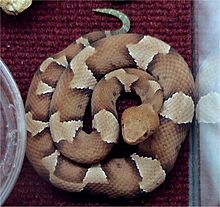- Agkistrodon contortrix laticinctus
-
Agkistrodon contortrix laticinctus 
Scientific classification Kingdom: Animalia Phylum: Chordata Subphylum: Vertebrata Class: Reptilia Order: Squamata Suborder: Serpentes Family: Viperidae Subfamily: Crotalinae Genus: Agkistrodon Species: A. contortrix Subspecies: A. c. laticinctus Trinomial name Agkistrodon contortrix laticinctus
Gloyd & Conant, 1934Synonyms Agkistrodon contortrix laticinctus is a venomous pitviper subspecies[3] found in the southern United States, from Kansas, through Oklahoma and throughout central Texas.
Contents
Description
This form is typically a light tan in color, with darker brown, wide crossbands - which gives it its common name. Their actual color varies by locality, varying from a red-brown, to a gray-brown. In the western reaches of its range, the species can be difficult to distinguish from the Trans-Pecos copperhead, A. c. pictigaster. The only notable physical difference between the subspecies is that the A. c. pictigaster tends to have an elaborately patterned underside, often being an irregular, white and black pattern whereas A. c. laticinctus tends to be plain white, only have minimal patterning, or have elongated random blotching instead of a distinct pattern. The subspecies intergrade where their ranges overlap, further confusing identification. It also overlaps with the southern copperhead, A. c. contortrix in the eastern reaches of its range, making specimens there difficult to distinguish, but generally A. c. contortrix has banding that narrows at the spine, creating hourglass shapes, whereas A. c. laticinctus has bands that do not narrow at the spine. They grow to approximately 20-36 inches (50–90 cm) in length. As juveniles, all species of Agkistrodon have a bright green-yellow color to their tail tip believed to be used as a lure to attract prey items to approach within striking range. The color fades to a grey or brown at about a year of age.
Common names
Broad-banded copperhead, copperhead moccasin, copperhead snake, dry-land moccasin, highland moccasin, moccasin, rattlesnake pilot, red eye, Texas copperhead, thunder snake.[2]
Behavior
Secretive and nocturnal, it prefers lightly wooded habitats, typically with a good amount of ground debris for cover, not far from a permanent water source. They typically avoid regions with a significant population of humans. They are an ambush predator, eating lizards, frogs, and rodents, with juveniles having a taste for various kinds of insect, such as cicadas. They are ovoviviparous, giving birth to a litter of up to 8 young in the early fall.
Venom
Like most pit viper species, A. contortrix has a hemotoxic venom, which is delivered through hinged, hollow fangs set in the front of their jaw. The fangs work like hypodermic needles, injecting the venom in a single, quick striking motion. Copperhead venom is not considered to be life threatening to an otherwise healthy adult, but it can cause localized swelling, necrosis, and severe pain. Any bite from a venomous snake should be considered serious and medical treatment sought. There is no antivenin specifically manufactured for copperheads, but CroFab, which makes use of the venom from the Cottonmouth (Agkistrodon piscivorus), and can be used in cases of a severe envenomation.
See also
- List of crotaline species and subspecies
- Crotalinae by common name
- Crotalinae by taxonomic synonyms
- Snakebite
References
- ^ McDiarmid RW, Campbell JA, Touré T. 1999. Snake Species of the World: A Taxonomic and Geographic Reference, vol. 1. Herpetologists' League. 511 pp. ISBN 1-893777-00-6 (series). ISBN 1-893777-01-4 (volume).
- ^ a b Wright AH, Wright AA. 1957. Handbook of Snakes. Comstock Publishing Associates. (7th printing, 1985). 1105 pp. ISBN 0-8014-0463-0.
- ^ "Agkistrodon contortrix laticinctus". Integrated Taxonomic Information System. http://www.itis.gov/servlet/SingleRpt/SingleRpt?search_topic=TSN&search_value=209498. Retrieved 15 May 2007.
External links
- Agkistrodon contortrix at the Reptarium.cz Reptile Database. Accessed 7 December 2007.
- Agkistrodon contortrix at University of Texas. Accessed 7 December 2007.
Categories:- Crotalinae
- Reptiles of the United States
Wikimedia Foundation. 2010.

